Heydar Aliyev Center was "an incredibly ambitious project" says Zaha Hadid
Architect Zaha Hadid has described her Heydar Aliyev Center in Baku, Azerbaijan as an "incredible achievement" while project architect Saffet Kaya Bekiroglu said the project expressed the "soft, romantic side" of Azeri culture (+ interview + movie).
"It was an incredible achievement for my team led by Saffet," said Hadid, speaking at the Designs of the Year award ceremony in London last night, where the building won the top prize.
"This was an incredibly ambitious project and for me," Hadid said. "It was always my dream to design and build the theoretical project and that was the closet thing to achieving that."
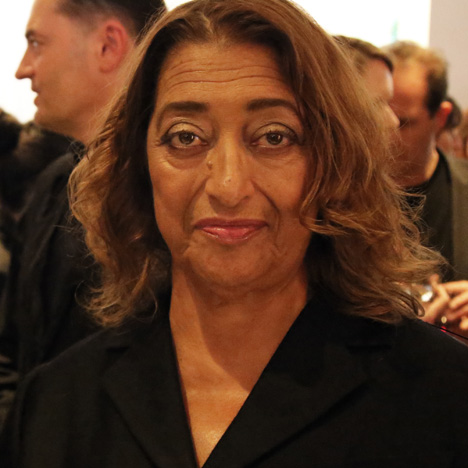
Hadid described the project, named after the former president of Azerbaijan, as one of her most important recent works, along with the London Aquatics Centre.
Saffet Kaya Bekiroglu, an associate at Zaha Hadid Architects who led the project, said the building reflected the romance and optimism of Azerbaijan, which gained independence from the Soviet Union in 1991.
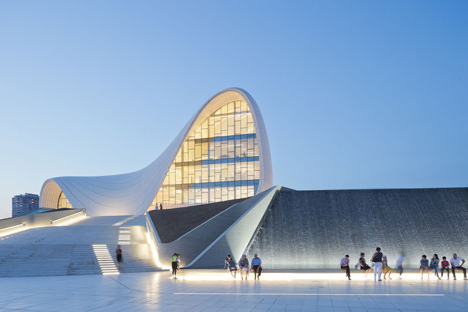
"They wanted to have something unique, something which is looking at the future, somehow showing their soft, romantic side but at the same time their optimistic side," said Bekiroglu in an interview with Dezeen.
"When you look at Soviet era [architecture in Azerbaijan], it's more like monumental internalised authoritarian buildings. So, this, we wanted to use this building as an opportunity to soften it up and totally depart from that."
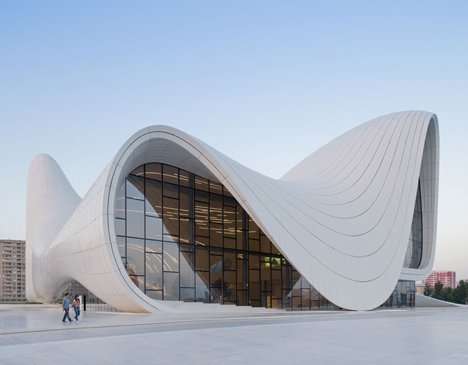
The centre, which contains exhibition spaces, a library, a museum and concert venues, is set in a public plaza, the ground of which rises up to form the building's wave-like shell.
"It blurs the rigid line between urban and architecture, inside and outside, flooring versus cladding and volume versus ground," said Bekiroglu.
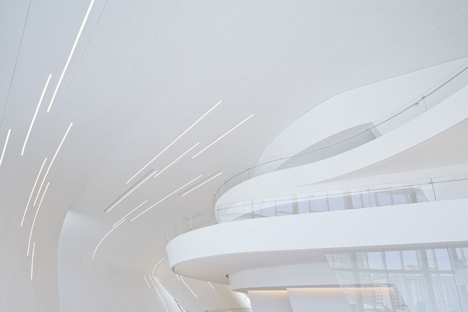
The building reflects the fluidity of traditional Azeri architecture, he said. "They have floral patterns and all this ornamentation [that] runs from the flooring to the walls and to the dome. So we wanted to that in a contemporary way."
Zaha Hadid won a competition to design the 57,000-square metre-building in 2007. Its shell is made out of a steel space frame and glass-fibre-reinforced concrete panels, concealing the vertical supports within the walls.
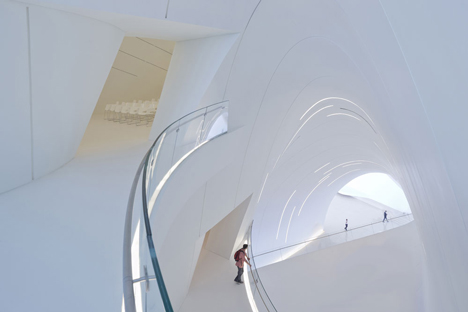
The Heydar Aliyev Center is the first architecture project to have won the overall title of Design of the Year in the Design Museum's annual awards, for which Dezeen is media partner.
Hadid topped the other category winners from this year's Designs of the Year, which included the Pro Chair family by Konstantin Grcic, ROLI's soft piano keyboard and Peek – a project that uses smartphones to make eye care affordable worldwide and available in remote locations.
The Spring Summer 2014 fashion collection by Prada was also recognised, as well as a series of installations of full-scale painted outlines of unmanned aircraft called Drone Shadows.
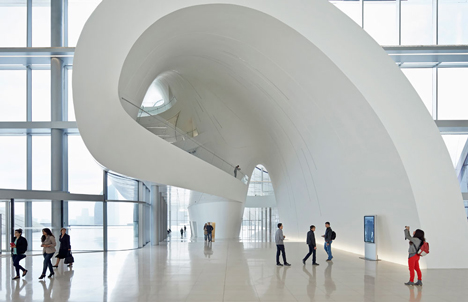
Past overall winners have included the 2014 Olympic Torch designed by Barber + Osgerby, the Plumen light bulb – the "world's first designer low energy light bulb" according to its creators – and Yves Behar's One Laptop Per Child project.
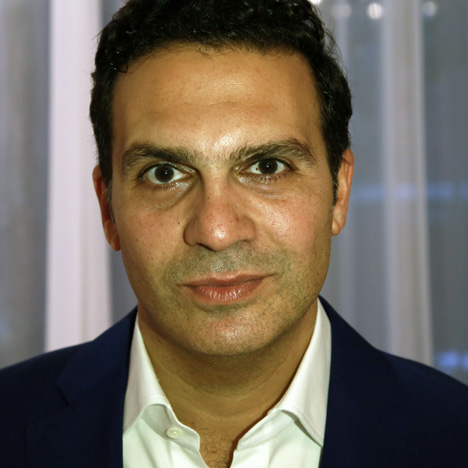
Photography used in the movie is by Hufton + Crow
Here’s an edited transcript of the interview with Saffet Kaya Bekiroglu of Zaha Hadid Architects:
Marcus Fairs: Tell me about the project.
Saffet Kaya Bekiroglu: It’s a public building of 110,000 square metres in Baku, which is the capital of Azerbaijan. It was completed last year and now it’s open for public use. The departure point of the design is the public plaza which is an urban ground, where urban ground undulates, folds put creates internalised urban space.
It’s located on the Heydar Aliyev Boulevard from the international airport to the old city, so in a way it kind of greets you, welcomes you, as you approach the city and it unfolds. Architecture is not something neutral, staying in the background. Architecture makes a statement.
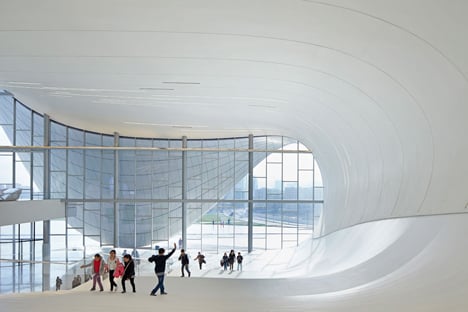
Marcus Fairs: What is it like working in Azerbaijan?
Saffet Kaya Bekiroglu: In this region, which is Eurasia, the Caucasus, contemporary architecture on this kind of scale hasn’t been done. So it's very exciting. If you look at the closest structures [on that scale], it’s the Hagia Sofia in Istanbul and the Taj Mahal in Agra. But in the region there is not much so I think that was very interesting to be able to bring that vision and knowhow.
Marcus Fairs: Tell me how that project came about.
Saffet Kaya Bekiroglu: It was a design-and-build competition so we teamed up with a contractor, DIA Holding. It’s a joint venture, a Turkish and Azeri collaboration. We made a proposal and they liked our proposal.
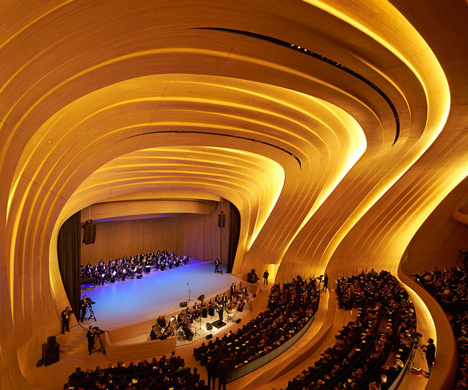
Marcus Fairs: Were they looking for something to compare to the Hagia Sofia or the Taj Mahal?
Saffet Kaya Bekiroglu: No. In 1991 Azerbaijan established its independence from the Soviet Union, so they wanted to have something unique, something which is looking at the future, somehow showing their soft, romantic side but at the same time their optimistic side.
Marcus Fairs: Tell us about the design. How does it compare to other projects the office has worked on?
Saffet Kaya Bekiroglu: Our office's work is a continuation of research and we're very interested in landscape, how we activate the ground, how the ground becomes inhabitable.
In this project the departure point was how we take a public building, a public plaza, which is an urban ground and it actually undulates, pulls up and creates an internalised urban space. In that sense, it blurs the rigid line between urban and architecture, inside and outside, flooring versus cladding and volume versus ground.
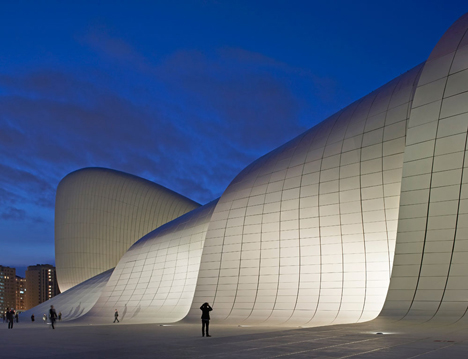
Marcus Fairs: How did you actually design it? Was it done using parametrics or more with sketches and models?
Saffet Kaya Bekiroglu: I mean we, as a team, are multi-tasking, so we work in all mediums: computing, sketching, physical models. Yes, we use computing to have super-numerical control, so all the unknowns are reduced to a minimum. So, especially I think parametric software is heavily used to develop the skin to make it more rational and efficient.
Marcus Fairs: How much of it is done by the computer and how much of it is done by you or a human being?
Saffet Kaya Bekiroglu: The computer is just a tool so we're the ones who push the buttons, we're the ones who provide the data, we're the ones who actually drive it. It's like a car. You drive the car and the car takes you.
But it's super controlled and actually we do a lot of sketches, we print [models]. Sometimes I believe that there's a certain relationship between the eye and the hand that is improvised; there is energy that sketches have. It's not like we're restricting ourselves to only the computer. We have many meetings as well. It's more about the thought and intention than the tool for us.
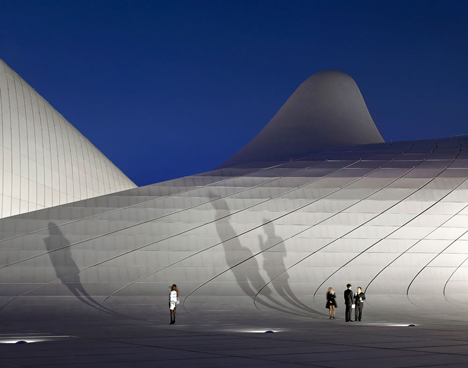
Marcus Fairs: What was the starting point of the research? Some of Zaha's projects have been derived from dune formations or geological formations. Where did the form of this one come from?
Saffet Kaya Bekiroglu: When you look at Soviet era [architecture in Azerbaijan], it's more like monumental internalised authoritarian buildings. So, this, we wanted to use this building as an opportunity to soften it up and totally depart from that. That's why urban ground as a public ground is the departure point.
Marcus Fairs: So the form, which rises up from the ground; was there a reference point for that?
Saffet Kaya Bekiroglu: Our design is not iconographic, that it looks like something and tries to mimic it. It's more about the idea. For public use, the public plaza is the departure point. Internalised urban space departing from the public plaza. It's not like any figure or any icon or anything.
Marcus Fairs: There's no visual precedent?
Saffet Kaya Bekiroglu: Well I can tell you about the fluidity. I always say there's a fluidity in that region that always existed. If you look at the region's architecture and its art: calligraphy, carpets. They have floral patterns and all this ornamentation [that] runs from the flooring to the walls and to the dome. So we wanted to that in a contemporary way.
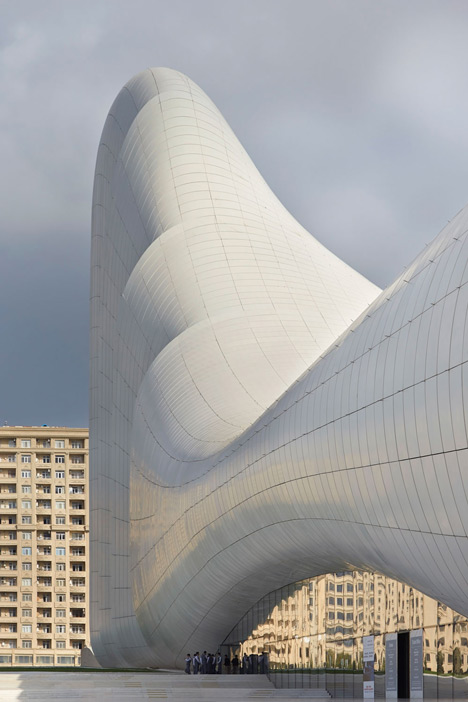
Marcus Fairs: What has the building done for the country and for the city?
Saffet Kaya Bekiroglu: I think it gives an interesting perspective to the Azeri people and Azeri culture. I see the building as like kind of social catalyst. I think they enjoy it and it's a new perspective. And it's a nice place for people and their family to go or if they're visiting internationally. It's located just between the airport and the old city as you're arriving along the boulevard. It's a nice building that welcomes you and there are art shows, lectures, opera. So it's a good social place for people to come to learn and exchange.
Marcus Fairs: Azerbaijan is bringing in other international architects to do projects. How is the country using architecture to express what it is all about?
Saffet Kaya Bekiroglu: Well I can not tell you all about that, but I think it's good that they're going with contemporary architecture, which reflects their ambitions and optimism.